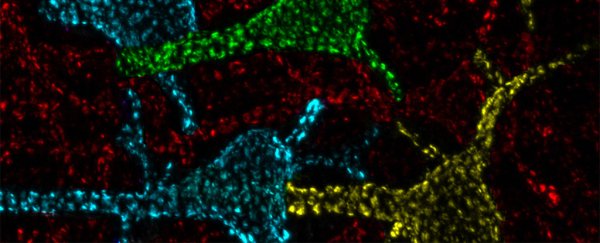The role of certain clusters of proteins found on the surface of brain cells in the hippocampus – the part of the brain that plays a key role in learning and memory – has been puzzling scientists for several decades now. But this particular biological mystery might, at last, have been solved.
It was already known that disruption to these clusters could lead to severe neurological disorders, but it wasn't clear why. A new study suggests the clusters are calcium-signaling 'hotspots' that are vital in activating gene expression.
The hotspot proteins appear to be unusually large ion channels, gateways that allow charged atoms into the cell. Exchanges of these ions are one of the main ways cells like neurons communicate to each other – passing on a signal like a touch, or the patterns of thought, from one group of cells to another so we can process them consciously.
"We have known the function of other types of ion channel clusters, for example, those at synapses, for a long time," says physiologist James Trimmer from the University of California, Davis.
"However, there was no known role that these much larger structures on the cell body played in the physiology of the neuron."
Trimmer and his colleagues had already detected multiple channels through these protein clusters, some that allow only potassium ions through a cell's membrane, while others are only for calcium ions.
Through experiments on rodent neurons, the team uncoupled the potassium and calcium channels, which have protein bits that bind to each other. They flooded the neurons with decoy potassium channel fragments that the calcium channels latched on to before falling away from the cell membrane clusters.
This was shown to break the link between electrical neural cell signaling and gene expression, a critical process in a properly functioning brain called the excitation-transcription coupling.
"There are a lot of different calcium channels, but the particular type of calcium channel found at these clusters is necessary for converting changes in electrical activity to changes in gene expression," says Trimmer.
"We found that if you interfere with the calcium-signaling proteins located at these unusual clusters, you basically eliminate excitation-transcription coupling, which is critical for learning, memory, and other forms of neuronal plasticity."
Calcium signaling is well studied in dendrites, the extended bits of neurons that manage messages between the cells, but before now there hasn't been much research into how calcium signaling might work inside the actual neuron cell body.
As the researchers explain, these neuron clusters are "highly conserved", which means that they have remained relatively unchanged by evolutionary processes. That points to their importance in invertebrates and vertebrates, including humans. As many as 100 clusters can be clamped to a single cell.
Scientists are constantly making new discoveries about how the brain works, and each additional insight into this most complex and sophisticated of organs can help to fix problems with its operation – or stop them from happening in the first place.
"We are only at the beginning of understanding the significance of this signaling, but these new results may provide information that could shape new research into its role in brain function, and perhaps eventually into the development of new classes of therapeutics," says Trimmer.
The research has been published in PNAS.
